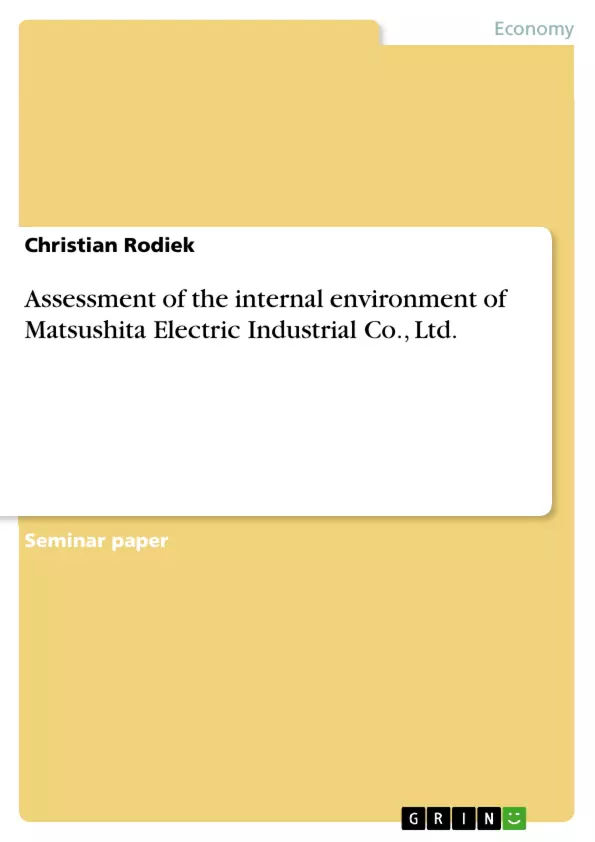This paper will analyze and assess the internal environment of Matsushita Electronic Industrial Co., Ltd.(Matsushita). Through the interpretation and discus-sion of the company′s financials and financial ratios as well as the description of its core competencies, firm resources and opportunities for improvement the pa-per will reach an assessment of the company′s current competitive standing and conclude with some suggestions of how to improve the company′s position in its industry.
Inhaltsverzeichnis (Table of Contents)
- Introduction
- Company Overview
- Financial Results
- Stock Price and Earnings per Share (EPS)
- Financial Ratios
- Return on Equity (ROE)
- Acid Ratio
- Debt to Equity (D/E) Ratio
- Times Interest Earned (TIE) Ratio
- Core Competencies, Firm Resources and Opportunities for Improvement
- References
Zielsetzung und Themenschwerpunkte (Objectives and Key Themes)
This paper aims to analyze and assess the internal environment of Matsushita Electronic Industrial Co., Ltd. (Matsushita) by examining its financial performance, core competencies, firm resources, and opportunities for improvement. The paper seeks to evaluate Matsushita's current competitive standing and conclude with suggestions for enhancing its position in the industry.
- Financial Performance Analysis
- Core Competencies and Firm Resources
- Opportunities for Improvement
- Competitive Standing Assessment
- Industry and Competitor Benchmarking
Zusammenfassung der Kapitel (Chapter Summaries)
- Introduction: Provides an overview of the paper's objectives and scope, outlining the analysis of Matsushita's internal environment.
- Company Overview: Introduces Matsushita as a Japanese multinational corporation headquartered in Osaka, Japan, and the world's largest producer of consumer electronics. It highlights the company's diverse product range, marketed under various brand names including Panasonic, Technics, National, Quasar, Victor, JVC, and PanaHome.
- Financial Results: Discusses Matsushita's stock price and earnings per share (EPS) trends from 2002 to 2006. It highlights the positive growth in stock price and EPS during this period, attributing the increase to various factors including the company's financial performance. The chapter then provides an overview of the key financial ratios used to analyze Matsushita's financial health, categorized into profitability, debt management, and liquidity ratios.
- Return on Equity (ROE): This chapter delves into the analysis of Matsushita's ROE, comparing it to industry benchmarks and a major competitor, Sony. It highlights the positive trend in ROE from 2002 to 2006, indicating Matsushita's ability to generate returns for its owners.
- Acid Ratio: This section examines Matsushita's acid ratio, a measure of the company's ability to cover its short-term liabilities with quick assets. It highlights the consistent acid ratio above "1" from 2002 to 2006, indicating strong liquidity and ability to meet short-term obligations.
- Debt to Equity (D/E) Ratio: The chapter focuses on Matsushita's D/E ratio, highlighting the decreasing trend from 2002 to 2006, indicating a reduction in debt and increased reliance on equity. This is presented as a sign of financial strength and reduced risk of bankruptcy.
- Times Interest Earned (TIE) Ratio: This section analyzes Matsushita's TIE ratio, demonstrating the company's ability to cover its interest payments with operating income. The chapter highlights the significant increase in TIE from 2002 to 2006, reflecting a reduced risk of bankruptcy and increased financial stability.
Schlüsselwörter (Keywords)
The primary focus of this paper is on the internal environment of Matsushita Electric Industrial Co., Ltd., encompassing financial performance analysis, core competencies, firm resources, and opportunities for improvement. Key keywords and concepts include financial ratios such as return on equity (ROE), acid ratio, debt to equity (D/E) ratio, and times interest earned (TIE) ratio. The paper also explores industry benchmarking, competitive analysis, and strategies for enhancing Matsushita's competitive position in the consumer electronics market.
- Citation du texte
- Christian Rodiek (Auteur), 2007, Assessment of the internal environment of Matsushita Electric Industrial Co., Ltd., Munich, GRIN Verlag, https://www.grin.com/document/71162



